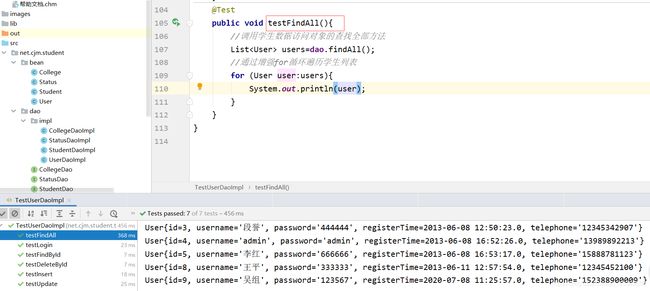GUI学生信息管理系统(5)
在net.cjm.student.dao包里面创建impl子包,然后在子包里面春节4个数据访问接口实现类

1.创建学校数据访问接口实现类CollegeDaoImpl
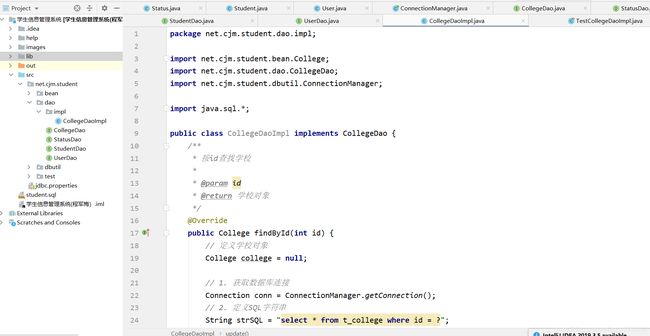
完成相应代码
package net.cjm.student.dao.impl;
import net.cjm.student.bean.College;
import net.cjm.student.dao.CollegeDao;
import net.cjm.student.dbutil.ConnectionManager;
import java.sql.*;
public class CollegeDaoImpl implements CollegeDao {
/**
* 按id查找学校
*
* @param id
* @return 学校对象
*/
@Override
public College findById(int id) {
// 定义学校对象
College college = null;
// 1. 获取数据库连接
Connection conn = ConnectionManager.getConnection();
// 2. 定义SQL字符串
String strSQL = "select * from t_college where id = ?";
try {
// 3. 创建预备语句对象
PreparedStatement pstmt = conn.prepareStatement(strSQL);
// 4. 设置占位符的值
pstmt.setInt(1, id);
// 5. 执行SQL,返回结果集
ResultSet rs = pstmt.executeQuery();
// 6. 判断结果集是否有记录
if (rs.next()) {
// 实例化学校对象
college = new College();
// 利用当前记录各个字段值去设置学校对象的属性
college.setId(rs.getInt("id"));
college.setName(rs.getString("name"));
college.setPresident(rs.getString("president"));
college.setStartTime(rs.getTimestamp("start_time"));
college.setTelephone(rs.getString("telephone"));
college.setEmail(rs.getString("email"));
college.setAddress(rs.getString("address"));
college.setProfile(rs.getString("profile"));
}
// 7. 关闭预备语句对象
pstmt.close();
// 8. 关闭结果集对象
rs.close();
} catch (SQLException e) {
e.printStackTrace();
} finally {
// 关闭数据库连接
ConnectionManager.closeConnection(conn);
}
// 返回学校对象
return college;
}
/**
* 更新学校信息
*
* @param college
* @return 更新记录数
*/
@Override
public int update(College college) {
// 定义更新记录数
int count = 0;
// 1. 获取数据库连接
Connection conn = ConnectionManager.getConnection();
// 2. 定义SQL字符串
String strSQL = "update t_college set name = ?, president = ?, start_time = ?,"
+ " telephone = ?, email = ?, address = ?, profile = ? where id = ?";
try {
// 3. 创建预备语句对象
PreparedStatement pstmt = conn.prepareStatement(strSQL);
// 4. 设置占位符的值
pstmt.setString(1, college.getName());
pstmt.setString(2, college.getPresident());
pstmt.setTimestamp(3, new Timestamp(college.getStartTime().getTime()));
pstmt.setString(4, college.getTelephone());
pstmt.setString(5, college.getEmail());
pstmt.setString(6, college.getAddress());
pstmt.setString(7, college.getProfile());
pstmt.setInt(8, college.getId());
// 5. 执行SQL,返回更新记录数
count = pstmt.executeUpdate();
// 6. 关闭预备语句对象
pstmt.close();
} catch (SQLException e) {
e.printStackTrace();
} finally {
// 关闭数据库连接
ConnectionManager.closeConnection(conn);
}
// 返回更新记录数
return count;
}
}
对CollegeDaoImple进行单元测试,采用JUnit4单元测试框架,在net.cjm.student中单独创建一个test 包,在test包中创建TestCollegeDaoImple

编写teatFindById和TestUpdate方法,并对他进行测试,记住将JUnit4添加到路径,才能使用@Test
*鼠标移动到@Test,按Alt+Enter,*弹出快捷菜单后选择第一项,因为操作时忘记录视频,使用无法具体讲解
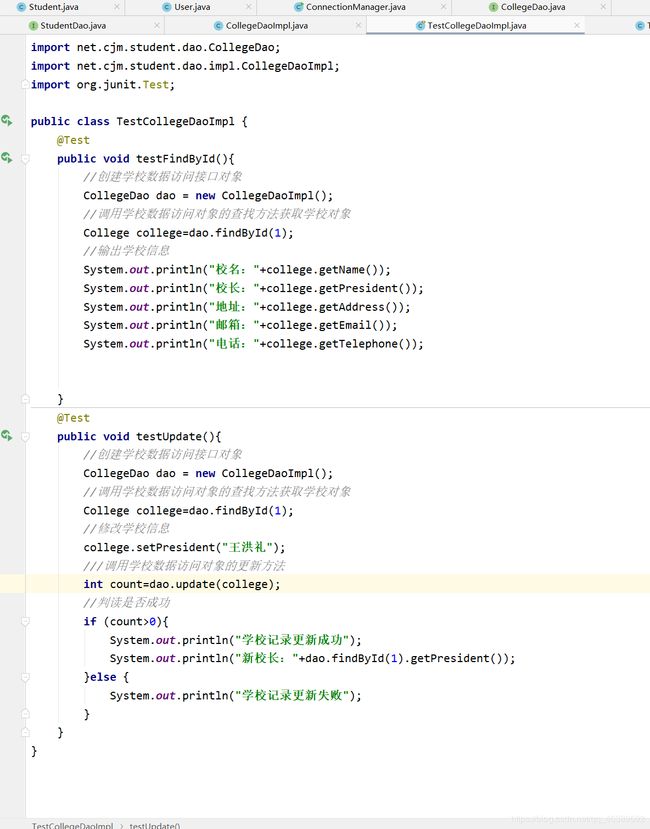
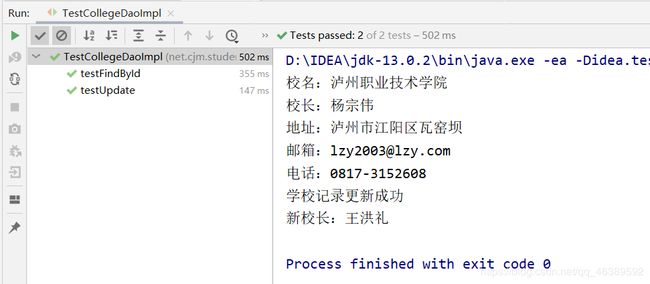
在这里我没有单独测试,是进行的多个一起测试,效率更高
对代码进行修改完善,因为两个测试方法第一行代码都一样,所以将他提取出来
因为是在每个代码之前和之后都要执行的代码 所以加上@Before和@After


重新进行测试

2.创建状态数据访问接口实现类StatusDaoImpl

进行代码写入
package net.cjm.student.dao.impl;
import net.cjm.student.bean.Status;
import net.cjm.student.dao.StatusDao;
import net.cjm.student.dbutil.ConnectionManager;
import java.sql.Connection;
import java.sql.PreparedStatement;
import java.sql.ResultSet;
import java.sql.SQLException;
public class StatusDaoImpl implements StatusDao {
@Override
public Status findById(int id) {
// 声明状态对象
Status status = null;
// 1. 获取数据库连接对象
Connection conn = ConnectionManager.getConnection();
// 2. 定义SQL字符串
String strSQL = "SELECT * FROM t_status WHERE id = ?";
try {
// 3. 创建预备语句对象
PreparedStatement pstmt = conn.prepareStatement(strSQL);
// 4. 设置占位符的值
pstmt.setInt(1, id);
// 5. 执行SQL查询,返回结果集
ResultSet rs = pstmt.executeQuery();
// 6. 判断结果集是否有记录
if (rs.next()) {
// 实例化状态
status = new Status();
// 利用当前记录字段值去设置状态对象的属性
status.setId(rs.getInt("id"));
status.setCollege(rs.getString("college"));
status.setVersion(rs.getString("version"));
status.setAuthor(rs.getString("author"));
status.setTelephone(rs.getString("telephone"));
status.setAddress(rs.getString("address"));
status.setEmail(rs.getString("email"));
}
// 7. 关闭预备语句对象
pstmt.close();
// 8. 关闭结果集对象
rs.close();
} catch (SQLException e) {
e.printStackTrace();
} finally {
// 关闭数据库连接
ConnectionManager.closeConnection(conn);
}
// 返回状态对象
return status;
}
@Override
public int update(Status status) {
// 定义更新记录数
int count = 0;
// 1. 获得数据库连接
Connection conn = ConnectionManager.getConnection();
// 2. 定义SQL字符串
String strSQL = "update t_status set college = ?, version = ?, author = ?,"
+ " telephone = ?, address = ?, email = ? where id = ?";
try {
// 3. 创建预备语句对象
PreparedStatement pstmt = conn.prepareStatement(strSQL);
// 4. 设置占位符的值
pstmt.setString(1, status.getCollege());
pstmt.setString(2, status.getVersion());
pstmt.setString(3, status.getAuthor());
pstmt.setString(4, status.getTelephone());
pstmt.setString(5, status.getAddress());
pstmt.setString(6, status.getEmail());
pstmt.setInt(7, status.getId());
// 5. 执行更新操作,更新记录
count = pstmt.executeUpdate();
// 6. 关闭预备语句对象
pstmt.close();
} catch (SQLException e) {
e.printStackTrace();
} finally {
// 关闭数据库连接
ConnectionManager.closeConnection(conn);
}
// 返回更新记录数
return count;
}
}
继续在test包里创建TestStatusDaoImpl对StatusDaoImpl进行单元测试
编写testFindById和testUpdate测试方法
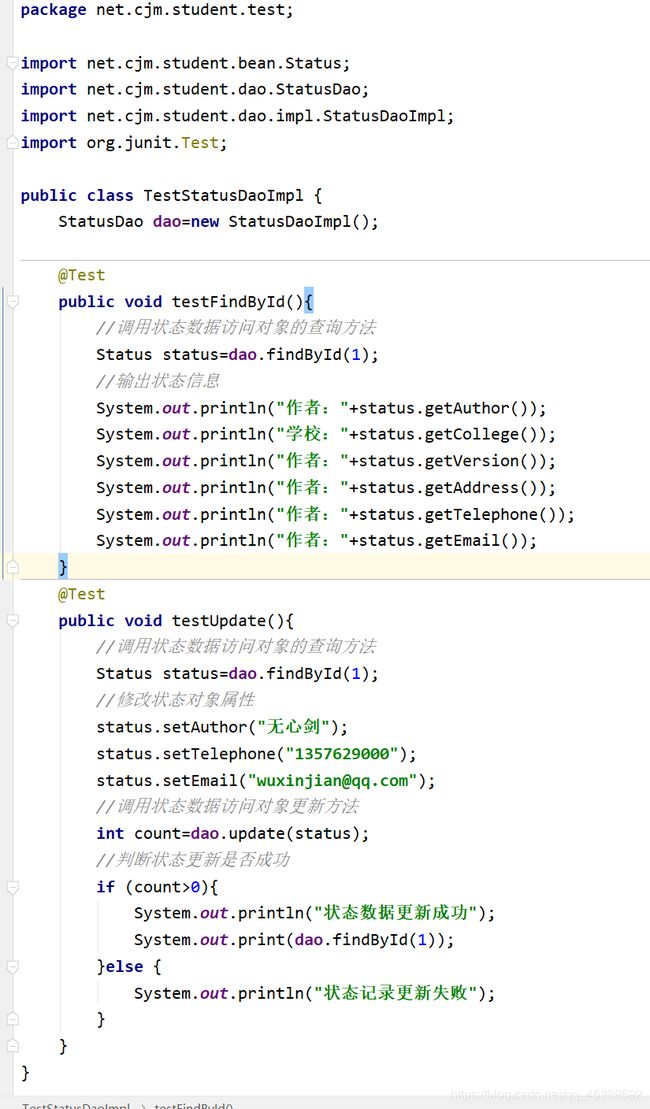
运行,查看测试结果

3.创建学生数据访问接口实现类StudentDaoImpl
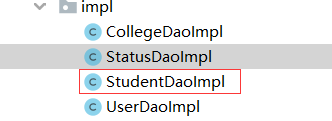
进行代码填写
package net.cjm.student.dao.impl;
import net.cjm.student.bean.Student;
import net.cjm.student.dao.StudentDao;
import net.cjm.student.dbutil.ConnectionManager;
import java.sql.*;
import java.util.ArrayList;
import java.util.List;
import java.util.Vector;
public class StudentDaoImpl implements StudentDao {
/**
* 插入学生记录
*
* @param student
* @return 插入记录数
*/
@Override
public int insert(Student student) {
// 定义插入记录数
int count = 0;
// 1. 获得数据库连接
Connection conn = ConnectionManager.getConnection();
// 2. 定义SQL字符串
String strSQL = "insert into t_student (id, name, sex, age, department, class, telephone)"
+ " values (?, ?, ?, ?, ?, ?, ?)";
try {
// 3. 创建预备语句对象
PreparedStatement pstmt = conn.prepareStatement(strSQL);
// 4. 设置占位符的值
pstmt.setString(1, student.getId());
pstmt.setString(2, student.getName());
pstmt.setString(3, student.getSex());
pstmt.setInt(4, student.getAge());
pstmt.setString(5, student.getDepartment());
pstmt.setString(6, student.getClazz());
pstmt.setString(7, student.getTelephone());
// 5. 执行SQL,返回插入记录数
count = pstmt.executeUpdate();
// 6. 关闭预备语句对象
pstmt.close();
} catch (SQLException e) {
e.printStackTrace();
} finally {
// 关闭数据库连接
ConnectionManager.closeConnection(conn);
}
// 返回插入记录数
return count;
}
/**
* 按学号删除学生记录
*
* @param id
* @return 删除记录数
*/
@Override
public int deleteById(String id) {
// 定义删除记录数
int count = 0;
// 1. 获取数据库连接
Connection conn = ConnectionManager.getConnection();
// 2. 定义SQL字符串
String strSQL = "delete from t_student where id = ?";
try {
// 3. 创建预备语句对象
PreparedStatement pstmt = conn.prepareStatement(strSQL);
// 4. 设置占位符的值
pstmt.setString(1, id);
// 5. 执行SQL,返回删除记录数
count = pstmt.executeUpdate();
// 6. 关闭预备语句对象
pstmt.close();
} catch (SQLException e) {
e.printStackTrace();
} finally {
// 关闭数据库连接
ConnectionManager.closeConnection(conn);
}
// 返回删除记录数
return count;
}
/**
* 按班级删除学生记录
*
* @param clazz
* @return 删除记录数
*/
@Override
public int deleteByClass(String clazz) {
// 定义删除记录数
int count = 0;
// 1. 获取数据库连接
Connection conn = ConnectionManager.getConnection();
// 2. 定义SQL字符串
String strSQL = "delete from t_student where class = ?";
try {
// 3. 创建预备语句对象
PreparedStatement pstmt = conn.prepareStatement(strSQL);
// 4. 设置占位符的值
pstmt.setString(1, clazz);
// 5. 执行SQL,返回删除记录数
count = pstmt.executeUpdate();
// 6. 关闭预备语句对象
pstmt.close();
} catch (SQLException e) {
e.printStackTrace();
} finally {
// 关闭数据库连接
ConnectionManager.closeConnection(conn);
}
// 返回删除记录数
return count;
}
/**
* 按系部删除学生记录
*
* @param department
* @return 删除记录数
*/
@Override
public int deleteByDepartment(String department) {
// 定义删除记录数
int count = 0;
// 1. 获得数据库连接
Connection conn = ConnectionManager.getConnection();
// 2. 定义SQL字符串
String strSQL = "delete from t_student where department = ?";
try {
// 3. 创建预备语句对象
PreparedStatement pstmt = conn.prepareStatement(strSQL);
// 4. 设置占位符的值
pstmt.setString(1, department);
// 5. 执行SQL,返回删除记录数
count = pstmt.executeUpdate();
// 6. 关闭预备语句对象
pstmt.close();
} catch (SQLException e) {
e.printStackTrace();
} finally {
// 关闭数据库连接
ConnectionManager.closeConnection(conn);
}
// 返回删除记录数
return count;
}
/**
* 更新学生记录
*
* @param student
* @return 更新记录数
*/
@Override
public int update(Student student) {
// 定义更新记录数
int count = 0;
// 1. 获得数据库连接
Connection conn = ConnectionManager.getConnection();
// 2. 定义SQL字符串
String strSQL = "update t_student set name = ?, sex = ?, age = ?,"
+ " department = ?, class = ?, telephone = ? where id = ?";
try {
// 3. 创建预备语句对象
PreparedStatement pstmt = conn.prepareStatement(strSQL);
// 4. 设置占位符的值
pstmt.setString(1, student.getName());
pstmt.setString(2, student.getSex());
pstmt.setInt(3, student.getAge());
pstmt.setString(4, student.getDepartment());
pstmt.setString(5, student.getClazz());
pstmt.setString(6, student.getTelephone());
pstmt.setString(7, student.getId());
// 5. 执行SQL,返回更新记录数
count = pstmt.executeUpdate();
// 6. 关闭预备语句对象
pstmt.close();
} catch (SQLException e) {
e.printStackTrace();
} finally {
// 关闭数据库连接
ConnectionManager.closeConnection(conn);
}
// 返回更新记录数
return count;
}
/**
* 按学号查询学生记录
*
* @param id
* @return 学生实体
*/
@Override
public Student findById(String id) {
// 声明学生对象
Student student = null;
// 1. 获取数据库连接对象
Connection conn = ConnectionManager.getConnection();
// 2. 定义SQL字符串
String strSQL = "select * from t_student where id = ?";
try {
// 3. 创建预备语句对象
PreparedStatement pstmt = conn.prepareStatement(strSQL);
// 4. 设置占位符的值
pstmt.setString(1, id);
// 5. 执行SQL,返回结果集
ResultSet rs = pstmt.executeQuery();
// 6. 判断结果集是否有记录
if (rs.next()) {
// 创建学生实体
student = new Student();
// 利用当前记录各字段值设置学生实体属性
student.setId(rs.getString("id"));
student.setName(rs.getString("name"));
student.setSex(rs.getString("sex"));
student.setAge(rs.getInt("age"));
student.setDepartment(rs.getString("department"));
student.setClazz(rs.getString("class"));
student.setTelephone(rs.getString("telephone"));
}
} catch (SQLException e) {
e.printStackTrace();
} finally {
// 关闭数据库连接
ConnectionManager.closeConnection(conn);
}
// 返回学生对象
return student;
}
/**
* 按姓名查询学生记录
*
* @param name
* @return 学生列表
*/
@Override
public List findByName(String name) {
// 声明学生列表
List students = new ArrayList();
// 1. 获取数据库连接对象
Connection conn = ConnectionManager.getConnection();
// 2. 定义SQL字符串
String strSQL = "select * from t_student where name like ?";
try {
// 3. 创建预备语句对象
PreparedStatement pstmt = conn.prepareStatement(strSQL);
// 4. 设置占位符的值
pstmt.setString(1, name + "%");
// 5. 执行SQL,返回结果集
ResultSet rs = pstmt.executeQuery();
// 6. 遍历结果集
while (rs.next()) {
// 创建学生实体
Student student = new Student();
// 利用当前记录各字段值设置学生实体属性
student.setId(rs.getString("id"));
student.setName(rs.getString("name"));
student.setSex(rs.getString("sex"));
student.setAge(rs.getInt("age"));
student.setDepartment(rs.getString("department"));
student.setClazz(rs.getString("class"));
student.setTelephone(rs.getString("telephone"));
// 将实体添加到学生列表
students.add(student);
}
// 7. 关闭结果集
rs.close();
// 8. 关闭预备语句对象
pstmt.close();
} catch (SQLException e) {
e.printStackTrace();
} finally {
// 关闭数据库连接
ConnectionManager.closeConnection(conn);
}
// 返回学生列表
return students;
}
/**
* 按班级查询学生记录
*
* @param clazz
* @return 学生列表
*/
@Override
public List findByClass(String clazz) {
// 声明学生列表
List students = new ArrayList();
// 1. 获取数据库连接对象
Connection conn = ConnectionManager.getConnection();
// 2. 定义SQL字符串
String strSQL = "select * from t_student where class like ?";
try {
// 3. 创建预备语句对象
PreparedStatement pstmt = conn.prepareStatement(strSQL);
// 4. 设置占位符的值
pstmt.setString(1, clazz + "%");
// 5. 执行SQL,返回结果集
ResultSet rs = pstmt.executeQuery();
// 6. 遍历结果集
while (rs.next()) {
// 创建学生实体
Student student = new Student();
// 利用当前记录各字段值设置学生实体属性
student.setId(rs.getString("id"));
student.setName(rs.getString("name"));
student.setSex(rs.getString("sex"));
student.setAge(rs.getInt("age"));
student.setDepartment(rs.getString("department"));
student.setClazz(rs.getString("class"));
student.setTelephone(rs.getString("telephone"));
// 将实体添加到学生列表
students.add(student);
}
// 7. 关闭结果集
rs.close();
// 8. 关闭预备语句对象
pstmt.close();
} catch (SQLException e) {
e.printStackTrace();
} finally {
// 关闭数据库连接
ConnectionManager.closeConnection(conn);
}
// 返回学生列表
return students;
}
/**
* 按系部查询学生记录
*
* @param department
* @return 学生列表
*/
@Override
public List findByDepartment(String department) {
// 声明学生列表
List students = new ArrayList();
// 1. 获取数据库连接对象
Connection conn = ConnectionManager.getConnection();
// 2. 定义SQL字符串
String strSQL = "select * from t_student where department like ?";
try {
// 3. 创建预备语句对象
PreparedStatement pstmt = conn.prepareStatement(strSQL);
// 4. 设置占位符的值
pstmt.setString(1, department + "%");
// 5. 执行SQL,返回结果集
ResultSet rs = pstmt.executeQuery();
// 6. 遍历结果集
while (rs.next()) {
// 创建学生实体
Student student = new Student();
// 利用当前记录各字段值设置学生实体属性
student.setId(rs.getString("id"));
student.setName(rs.getString("name"));
student.setSex(rs.getString("sex"));
student.setAge(rs.getInt("age"));
student.setDepartment(rs.getString("department"));
student.setClazz(rs.getString("class"));
student.setTelephone(rs.getString("telephone"));
// 将实体添加到学生列表
students.add(student);
}
// 7. 关闭结果集
rs.close();
// 8. 关闭预备语句对象
pstmt.close();
} catch (SQLException e) {
e.printStackTrace();
} finally {
// 关闭数据库连接
ConnectionManager.closeConnection(conn);
}
// 返回学生列表
return students;
}
/**
* 查询全部学生记录
*
* @return 学生列表
*/
@Override
public List findAll() {
// 声明学生列表
List students = new ArrayList();
// 1. 获取数据库连接对象
Connection conn = ConnectionManager.getConnection();
// 2. 定义SQL字符串
String strSQL = "select * from t_student";
try {
// 3. 创建语句对象
Statement stmt = conn.createStatement();
// 4. 执行SQL,返回结果集
ResultSet rs = stmt.executeQuery(strSQL);
// 5. 遍历结果集
while (rs.next()) {
// 创建学生实体
Student student = new Student();
// 利用当前记录各字段值设置学生实体属性
student.setId(rs.getString("id"));
student.setName(rs.getString("name"));
student.setSex(rs.getString("sex"));
student.setAge(rs.getInt("age"));
student.setDepartment(rs.getString("department"));
student.setClazz(rs.getString("class"));
student.setTelephone(rs.getString("telephone"));
// 将实体添加到学生列表
students.add(student);
}
// 6. 关闭结果集
rs.close();
// 7. 关闭语句对象
stmt.close();
} catch (SQLException e) {
e.printStackTrace();
} finally {
// 关闭数据库连接
ConnectionManager.closeConnection(conn);
}
// 返回学生列表
return students;
}
/**
* 按性别统计学生人数
*
* @return 统计结果向量
*/
@Override
public Vector findRowsBySex() {
// 定义行集向量
Vector rows = new Vector();
// 1. 获取数据库连接对象
Connection conn = ConnectionManager.getConnection();
// 2. 定义SQL字符串
String strSQL = "select sex as '性别', count(*) as '人数'"
+ " from t_student group by sex order by sex desc";
try {
// 3. 创建语句对象
Statement stmt = conn.createStatement();
// 4. 执行SQL,返回结果集
ResultSet rs = stmt.executeQuery(strSQL);
// 5. 遍历结果集
while (rs.next()) {
// 定义当前行向量
Vector currentRow = new Vector();
// 利用当前记录字段值设置当前行向量的元素值
currentRow.addElement(rs.getString("性别"));
currentRow.addElement(rs.getInt("人数") + "");
// 将当前行向量添加到行集向量
rows.addElement(currentRow);
}
} catch (SQLException e) {
e.printStackTrace();
} finally {
// 关闭数据库连接
ConnectionManager.closeConnection(conn);
}
// 返回行集向量
return rows;
}
/**
* 按班级统计学生人数
*
* @return 统计结果向量
*/
@Override
public Vector findRowsByClass() {
// 定义行集向量
Vector rows = new Vector();
// 1. 获取数据库连接对象
Connection conn = ConnectionManager.getConnection();
// 2. 定义SQL字符串
String strSQL = "select class as '班级', count(*) as '人数'"
+ " from t_student group by class order by class desc";
try {
// 3. 创建语句对象
Statement stmt = conn.createStatement();
// 4. 执行SQL,返回结果集
ResultSet rs = stmt.executeQuery(strSQL);
// 5. 遍历结果集
while (rs.next()) {
// 定义当前行向量
Vector currentRow = new Vector();
// 利用当前记录字段值设置当前行向量的元素值
currentRow.addElement(rs.getString("班级"));
currentRow.addElement(rs.getInt("人数") + "");
// 将当前行向量添加到行集向量
rows.addElement(currentRow);
}
} catch (SQLException e) {
e.printStackTrace();
} finally {
// 关闭数据库连接
ConnectionManager.closeConnection(conn);
}
// 返回行集向量
return rows;
}
/**
* 按系部统计学生人数
*
* @return 统计结果向量
*/
@Override
public Vector findRowsByDepartment() {
// 定义行集向量
Vector rows = new Vector();
// 1. 获取数据库连接对象
Connection conn = ConnectionManager.getConnection();
// 2. 定义SQL字符串
String strSQL = "select department as '系部', count(*) as '人数'"
+ " from t_student group by department order by department desc";
try {
// 3. 创建语句对象
Statement stmt = conn.createStatement();
// 4. 执行SQL,返回结果集
ResultSet rs = stmt.executeQuery(strSQL);
// 5. 遍历结果集
while (rs.next()) {
// 定义当前行向量
Vector currentRow = new Vector();
// 利用当前记录字段值设置当前行向量的元素值
currentRow.addElement(rs.getString("系部"));
currentRow.addElement(rs.getInt("人数") + "");
// 将当前行向量添加到行集向量
rows.addElement(currentRow);
}
} catch (SQLException e) {
e.printStackTrace();
} finally {
// 关闭数据库连接
ConnectionManager.closeConnection(conn);
}
// 返回行集向量
return rows;
}
}
创建testStudentDaoImpl对StudentDaoImpl进行单元测试
编写testInsert和testDelete测试方法

运行查看结果

编写测试方法testDeleteByClass
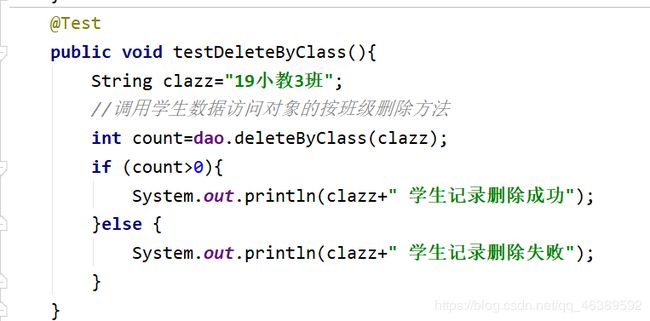
运行查看结果

编写测试方法testFindByName
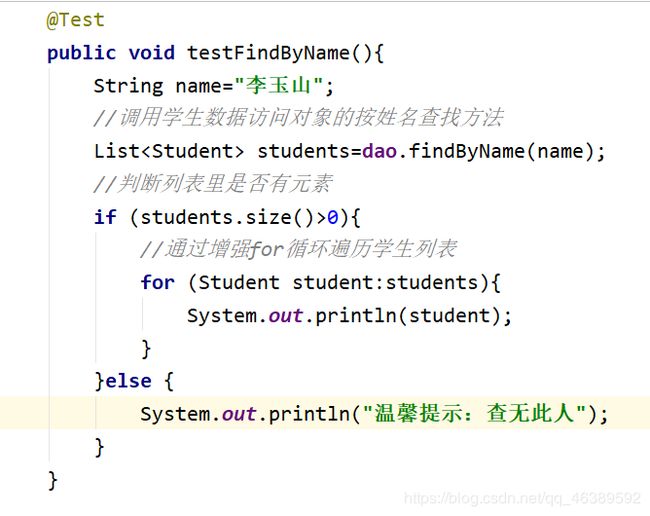
运行测试 查看结果

修改查看学生姓名

运行进行测试,查看结果

查找姓李的学生

测试结果并没有姓李的同学

编写测试方法testFindAll
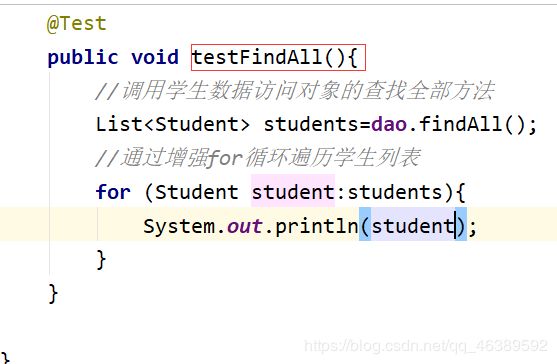
运行测试方法,查看结果

编写测试方法testFindRowBySex
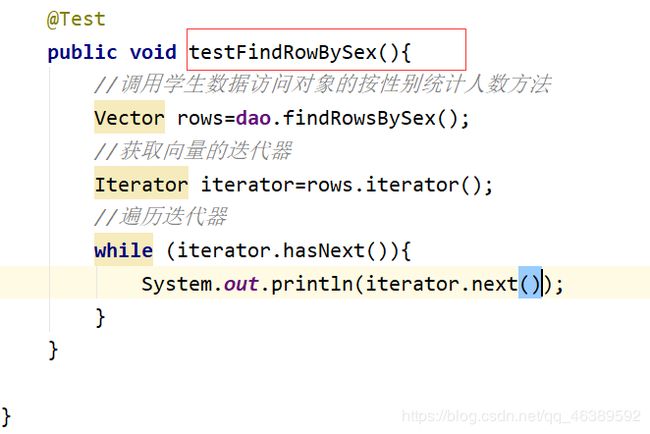
运行查看结果

编写测试方法testDeleteByDepartment
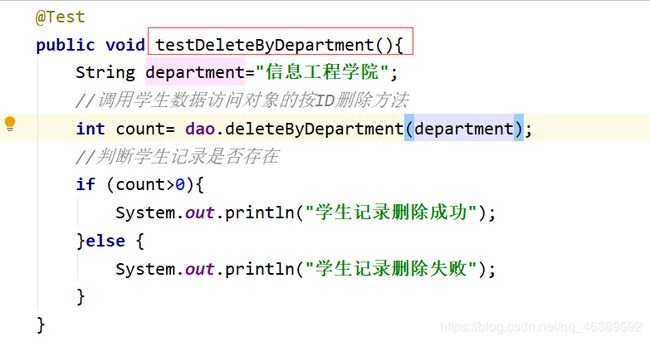
运行查看结果

编写测试方法teatUpdate方法

运行查看该结果

编写测试方法testFindById
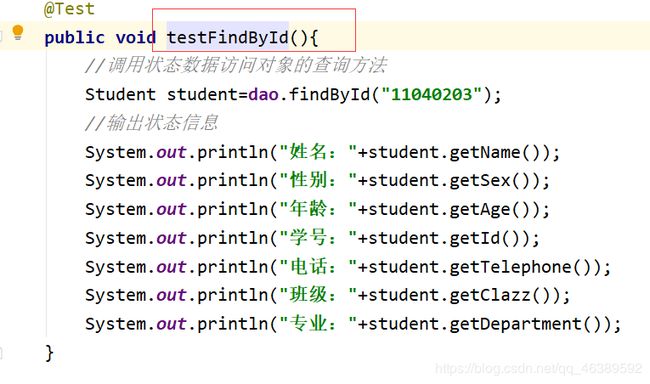
运行查看测试结果

编写测试方法teatFindByClass

运行查看测试结果

编写测试方法testFindByDepartment
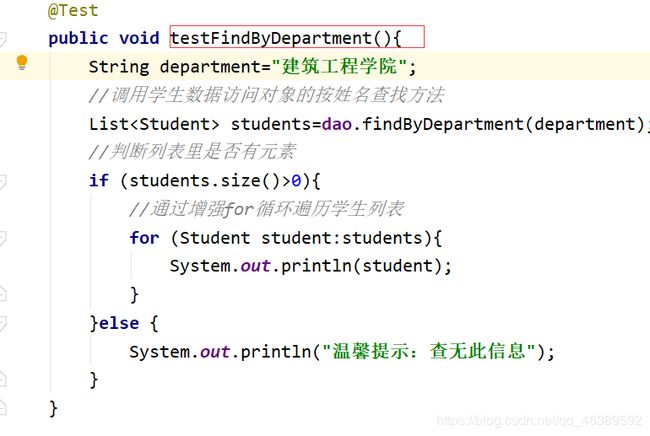
运行查看测试结果

编写测试方法testFindRowByClass
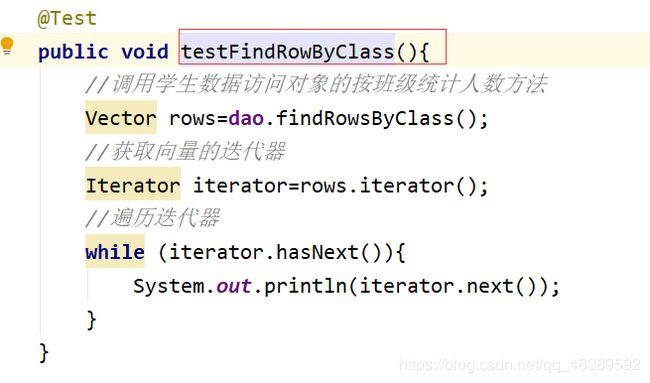
运行查看结果
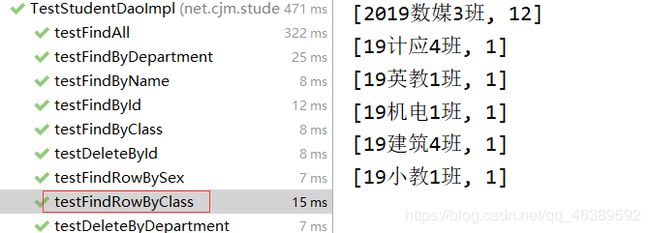
编写测试方法testFindRowByDepartment
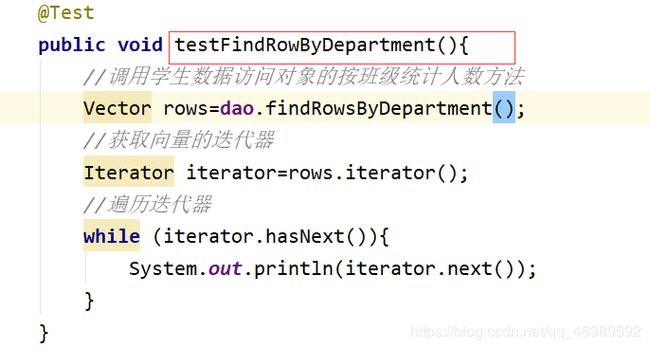
运行查看测试结果

4.创建用户数据访问接口实现类UserDaoImpl
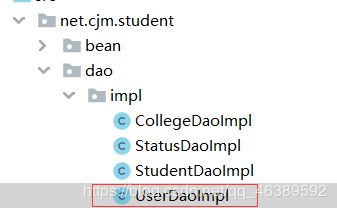
package net.cjm.student.dao.impl;
import net.cjm.student.bean.User;
import net.cjm.student.dao.UserDao;
import net.cjm.student.dbutil.ConnectionManager;
import java.sql.*;
import java.util.ArrayList;
import java.util.List;
/**
-
功能:用户数据访问接口实现类
-
作者:程军梅
-
日期:2020年06月05日
/
public class UserDaoImpl implements UserDao {
/*-
插入用户记录
-
@param user
-
@return 插入记录数
*/
@Override
public int insert(User user) {
// 定义插入记录数
int count = 0;// 1. 获得数据库连接
Connection conn = ConnectionManager.getConnection();
// 2. 定义SQL字符串
String strSQL = “insert into t_user (username, password, telephone, register_time)”
+ " values (?, ?, ?, ?)";// 不允许用户表里插入两条用户名相同的记录
if (!isUsernameExisted(user.getUsername())) {
try {
// 3. 创建预备语句对象
PreparedStatement pstmt = conn.prepareStatement(strSQL);
// 4. 设置占位符的值
pstmt.setString(1, user.getUsername());
pstmt.setString(2, user.getPassword());
pstmt.setString(3, user.getTelephone());
pstmt.setTimestamp(4, new Timestamp(user.getRegisterTime().getTime()));
// 5. 执行SQL,返回插入记录数
count = pstmt.executeUpdate();
// 6. 关闭预备语句对象
pstmt.close();
} catch (SQLException e) {
e.printStackTrace();
} finally {
// 关闭数据库连接
ConnectionManager.closeConnection(conn);
}
}// 返回插入记录数
return count;
}
/**
-
按id删除用户记录
-
@param id
-
@return 删除记录数
*/
@Override
public int deleteById(int id) {
// 定义删除记录数
int count = 0;// 1. 获取数据库连接
Connection conn = ConnectionManager.getConnection();
// 2. 定义SQL字符串
String strSQL = “delete from t_user where id = ?”;
try {
// 3. 创建预备语句对象
PreparedStatement pstmt = conn.prepareStatement(strSQL);
// 4. 设置占位符的值
pstmt.setInt(1, id);
// 5. 执行SQL,返回删除记录数
count = pstmt.executeUpdate();
// 6. 关闭预备语句对象
pstmt.close();
} catch (SQLException e) {
e.printStackTrace();
} finally {
// 关闭数据库连接
ConnectionManager.closeConnection(conn);
}// 返回删除记录数
return count;
}
/**
-
更新用户记录
-
@param user
-
@return 更新记录数
*/
@Override
public int update(User user) {
// 定义更新记录数
int count = 0;// 1. 获得数据库连接
Connection conn = ConnectionManager.getConnection();
// 2. 定义SQL字符串
String strSQL = “update t_user set username = ?, password = ?, telephone = ?,”
+ " register_time = ? where id = ?";
try {
// 3. 创建预备语句对象
PreparedStatement pstmt = conn.prepareStatement(strSQL);
// 4. 设置占位符的值
pstmt.setString(1, user.getUsername());
pstmt.setString(2, user.getPassword());
pstmt.setString(3, user.getTelephone());
pstmt.setTimestamp(4, new Timestamp(user.getRegisterTime().getTime()));
pstmt.setInt(5, user.getId());
// 5. 执行SQL,返回更新记录数
count = pstmt.executeUpdate();
// 6. 关闭预备语句对象
pstmt.close();
} catch (SQLException e) {
e.printStackTrace();
} finally {
// 关闭数据库连接
ConnectionManager.closeConnection(conn);
}// 返回更新记录数
return count;
}
/**
-
按id查询用户
-
@param id
-
@return 用户实体
*/
@Override
public User findById(int id) {
// 声明用户对象
User user = null;// 1. 获取数据库连接对象
Connection conn = ConnectionManager.getConnection();
// 2. 定义SQL字符串
String strSQL = “select * from t_user where id = ?”;
try {
// 3. 创建预备语句对象
PreparedStatement pstmt = conn.prepareStatement(strSQL);
// 4. 设置占位符的值
pstmt.setInt(1, id);
// 5. 执行SQL,返回结果集
ResultSet rs = pstmt.executeQuery();
// 6. 判断结果集是否有记录
if (rs.next()) {
// 创建用户实体
user = new User();
// 利用当前记录各字段值设置用户实体属性
user.setId(rs.getInt(“id”));
user.setUsername(rs.getString(“username”));
user.setPassword(rs.getString(“password”));
user.setTelephone(rs.getString(“telephone”));
user.setRegisterTime(rs.getTimestamp(“register_time”));
}
} catch (SQLException e) {
e.printStackTrace();
} finally {
// 关闭数据库连接
ConnectionManager.closeConnection(conn);
}// 返回用户对象
return user;
}
/**
-
查询所有用户
-
@return 用户列表
*/
@Override
public List findAll() {
// 声明用户列表
List users = new ArrayList();// 1. 获取数据库连接对象
Connection conn = ConnectionManager.getConnection();
// 2. 定义SQL字符串
String strSQL = “select * from t_user”;
try {
// 3. 创建语句对象
Statement stmt = conn.createStatement();
// 4. 执行SQL,返回结果集
ResultSet rs = stmt.executeQuery(strSQL);
// 5. 遍历结果集
while (rs.next()) {
// 创建用户实体
User user = new User();
// 利用当前记录各字段值设置用户实体属性
user.setId(rs.getInt(“id”));
user.setUsername(rs.getString(“username”));
user.setPassword(rs.getString(“password”));
user.setTelephone(rs.getString(“telephone”));
user.setRegisterTime(rs.getTimestamp(“register_time”));
// 将实体添加到用户列表
users.add(user);
}
// 6. 关闭结果集
rs.close();
// 7. 关闭语句对象
stmt.close();
} catch (SQLException e) {
e.printStackTrace();
} finally {
// 关闭数据库连接
ConnectionManager.closeConnection(conn);
}// 返回用户列表
return users;
}
/**
-
用户登录
-
@param username
-
@param password
-
@return 登录用户实体
*/
@Override
public User login(String username, String password) {
// 声明用户对象
User user = null;// 1. 获取数据库连接
Connection conn = ConnectionManager.getConnection();
// 2. 定义SQL字符串
String strSQL = “select * from t_user where username = ? and password = ?”;
try {
// 3. 创建预备语句对象
PreparedStatement pstmt = conn.prepareStatement(strSQL);
// 4. 设置占位符的值
pstmt.setString(1, username);
pstmt.setString(2, password);
// 5. 执行SQL,返回结果集
ResultSet rs = pstmt.executeQuery();
// 6. 判断结果集是否有记录
if (rs.next()) {
// 实例化用户
user = new User();
// 利用当前记录各字段值设置用户实体属性
user.setId(rs.getInt(“id”));
user.setUsername(rs.getString(“username”));
user.setPassword(rs.getString(“password”));
user.setTelephone(rs.getString(“telephone”));
user.setRegisterTime(rs.getTimestamp(“register_time”));
}
} catch (SQLException e) {
e.printStackTrace();
} finally {
// 关闭数据库连接
ConnectionManager.closeConnection(conn);
}// 返回用户对象
return user;
}
@Override
public boolean isUsernameExisted(String username) {
// 定义存在与否变量
boolean existed = false;// 1. 获取数据库连接 Connection conn = ConnectionManager.getConnection(); // 2. 定义SQL字符串 String strSQL = "select * from t_user where username = ?"; try { // 3. 创建预备语句对象 PreparedStatement pstmt = conn.prepareStatement(strSQL); // 4. 设置占位符的值 pstmt.setString(1, username); // 5. 执行SQL,返回结果集 ResultSet rs = pstmt.executeQuery(); // 6. 判断结果集是否有记录 if (rs.next()) { existed = true; } // 7. 关闭预备语句对象 pstmt.close(); // 8. 关闭结果集对象 rs.close(); } catch (SQLException e) { e.printStackTrace(); } finally { -
s // 关闭数据库连接
ConnectionManager.closeConnection(conn);
}
// 返回存在与否变量
return existed;
}
}
在net.cjm.student的test包里创建测试类TestUserDaoImpl
编写测试方法testFindById

运行查看测试结果

编写测试方法testLogin

运行查看测试结果

编写测试方法testLsUsernameExisted,并查看测试结果

将用户名修改成表里有的,重新运行查看结果
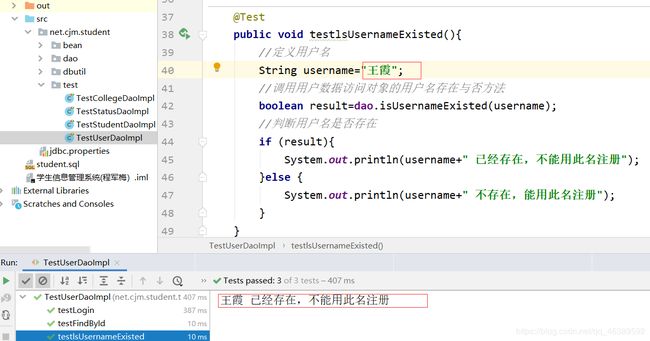
编写测试方法testInsert,运行查看测试结果
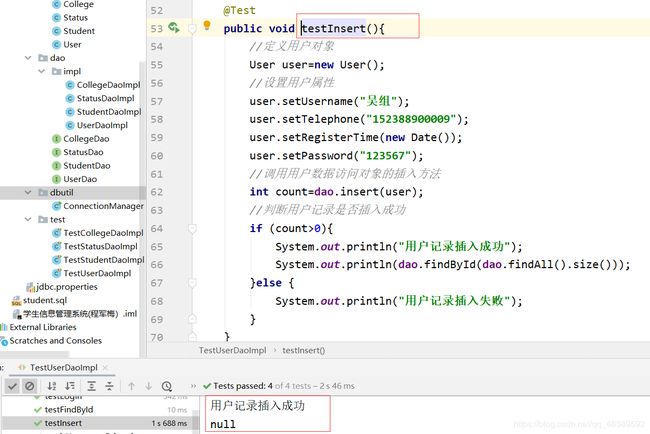
再次运行查看测试结果有什么差异

编写测试方法testDeleteById,运行查看测试结果

编写测试方法testUpdate,运行查看测试结果
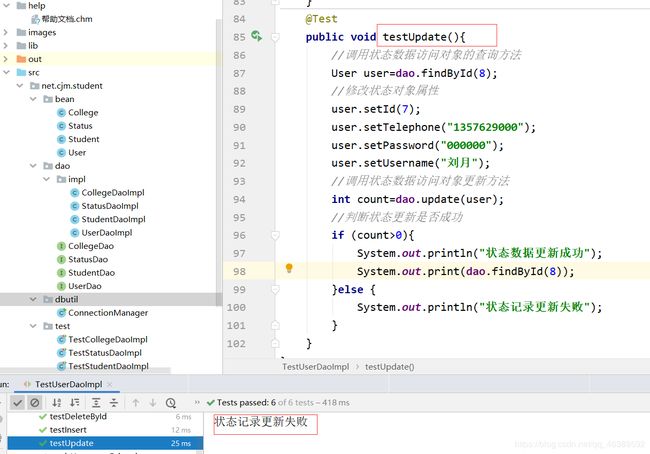
编写测试方法testFindAll,运行查看测试结果
